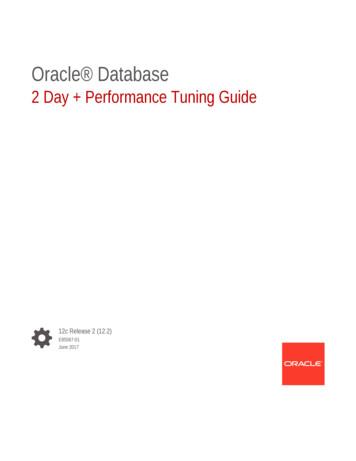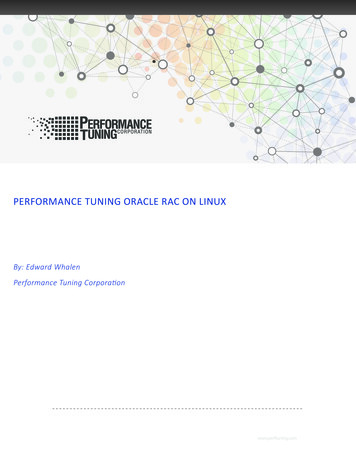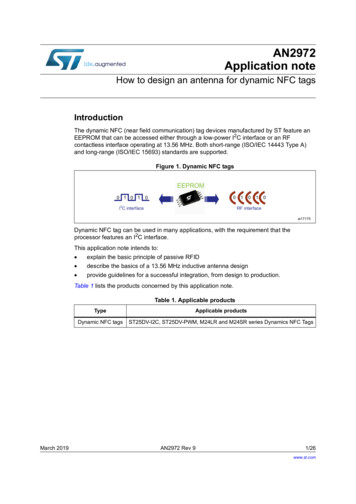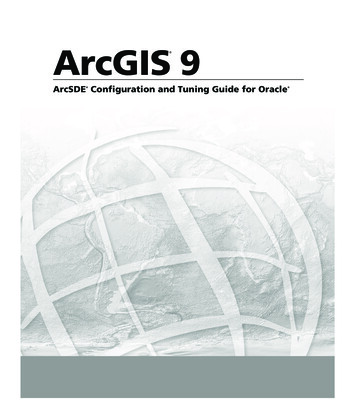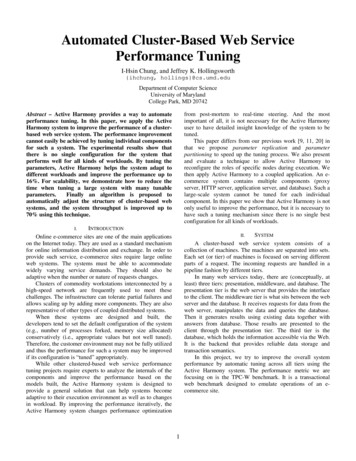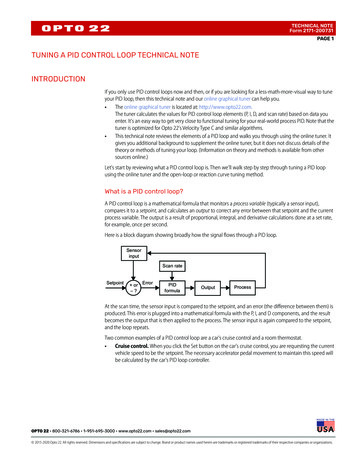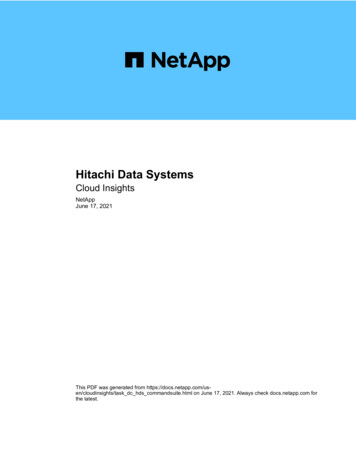
Transcription
Performance Analysis and Tuning – Part ID. John Shakshober (Shak) – Director Performance EngineeringLarry Woodman - Senior Consulting Engineer / Kernel VMJoe Mario - Senior Principal Performance Engineer / RHEL / Net / ToolsSanjay Rao – Principal Performance Engineer / Database
Agenda: Performance Analysis Tuning Part I Part I RHEL Evolution 5- 6- 7 , Hybrid Clouds / OSE / OSP tuned / CVE NonUniform Memory Access (NUMA) What is NUMA, RHEL Architecture, Auto-NUMA-Balance HugePages Static, Transparent, variable sized 4K/2MB/1GB Control Groups “Meet The Experts” - Free as in Soda/Beer/Wine
Agenda: Performance Analysis Tuning Part II Part II Disk and Filesystem IO - Database Throughput-performance Network Performance Latency-performance Tuned w/ cpu partition profile System Performance/Tools Perf, and Tuna, PCP Realtime RHEL7, KVM-RT and NFV w/ DPDK “Meet The Experts” - Free as in Soda/Beer/Wine
Red Hat Enterprise Linux Performance Evolution (fix)RHEL5HugepagesStaticKtune – on/offCPU Affinity(taskset)NUMA Pinning(numactl)IrqbalanceRHEL6RHEL7RH tRHV – out-of-the-boxTuned – choose profile Tuned – throughputvirt-host/guestperformance (default)RH OSP – blueprintsCPU AffinityCPU AffinityTuned, Numa pining(ts/numactl)(ts/numactl)NIC – jumbo sriovAutonuma-BalanceNUMAD – uerspaceRH OpenShift v3LXC –toolRH Sat 6Container/DockerCgroups RH Cloud Formsirqbalance – NUMAirqbalance – NUMAenhancedenhanced
Tuned Overview Installed by default New Profiles since last ye Realtime Auto-set Profiles NFV - cpu-partitioning Single config file RHEL Atomic Host Inheritance/Hooks bootloader/cmdline OpenShift OracleconfigsSee man tuned-profiles for profile definitions
Performance MetricsLatency SpeedLatency – Speed Limit- Ghz of CPU, Memory PCI- Small transfers, disableaggregation – TCP nodelay- Dataplane optimization DPDK,Throughput BandwidthThroughput: Bandwidth: # lanes in Highway- Width of data path / cachelines- Bus Bandwidth, QPI links, PCI 1-2-3- Network 1 / 10 / 40 Gb – aggregation, NAPI- Fiberchannel 4/8/16, SSD, NVME Drivers
Tuned: Your Custom estChildren/GrandchildrenYour Web ProfileYour Database ProfileYour Middleware Profile
Tuned - Profiles
Tuned: Storage Performance Boost:throughput-performance (default in RHEL7)Larger is better
RHEL Security mitigation for Meltdown / SpectreSpectre Variant 1: Bounds check bypass Addressed through speculative load barriers (lfence/new nops). Mitigation cannot be disabled. Variant 2: Indirect Branch Predictor poisoning Addressed through disabling the indirect branch predictor when runningkernel code to avoid influence from application code. Requires microcode/millicode/firmware updates from vendor. Mitigation can be disabled, defaults to being enabled.Meltdown Variant 3: Rogue cache data load Addressed through Page Table Isolation (pti - preventing kernel data andVA/PA translations from being present in certain CPU structures). Mitigation can be disabled, defaults to being enabled.10
Spectre / Meltdown performance impactfunc[user to kernel transitions & time in kernel]290139Userspace ( e.g. /bin/bash)System CallInterfaceOperating System (e.g. Linux kernel)11
Spectre / Meltdown ImpactVARIES BY WORKLOAD12
Spectre / Metldown Managing Perf Impact RHEL has transparent (thp) and static hugepagesReduces amount of TLB entries and thus total flushimpact RHEL uses PCID support where possible to reduces impactof TLB flushes by tagging/tracking RHEL has runtime knobs to disable patches (no reboot)–echo 0 /sys/kernel/debug/x86/pti enabledecho 0 /sys/kernel/debug/x86/ibrs enabledecho 0 /sys/kernel/debug/x86/retp enabled13
RHEL 6/7 Non-Uniform MemoryAccess (NUMA)
Typical Four-Node NUMA SystemNode 2Node 0Node 2 RAMNode 0 RAMCore 1Core 0Core 3Core 2Core 5Core 4Core 6Core 7Core 6Core 7Core 8Core 9Core 8Core 9Core.Core.Core 0Core 2L3 CacheCore 4Core 1L3 CacheCore 3Core 5QPI links, IO, etc.QPI links, IO, etc.Node 3Node 1Node 3 RAMNode 1 RAMCore 0Core 1Core 0Core 2Core 3Core 2Core 5Core 4Core 7Core 6Core 7Core 8Core 9Core 8Core 9Core.Core.Core 4L3 CacheCore 6QPI links, IO, etc.L3 CacheQPI links, IO, etc.Core 1Core 3Core 5
Four Node memory placement NUMA System
NUMA Nodes and Zones64-bitEnd of RAMNode 1Normal ZoneNormal ZoneNode 04GB DMA32 Zone16MB DMA Zone
Per Node / Zone split LRU Paging DynamicsUser CTIVEINACTIVEFREEReclaimingPage agingswapoutflushUser deletions
Interaction between VM Tunables and NUMA Dependent on NUMA: Reclaim Ratios /proc/sys/vm/swappiness /proc/sys/vm/min free kbytes /proc/sys/vm/zone reclaim mode Independent of NUMA: Reclaim Ratios /proc/sys/vm/vfs cache pressure Writeback Parameters /proc/sys/vm/dirty background ratio /proc/sys/vm/dirty ratio Readahead parameters /sys/block/ bdev /queue/read ahead kb
swappiness Controls how aggressively the system reclaims anonymous memoryversus pagecache memory: Anonymous memory – swapping and freeing File pages – writing if dirty and freeing System V shared memory – swapping and freeing Default is 60 Decrease: more aggressive reclaiming of pagecache memory Increase: more aggressive swapping of anonymous memory Can effect Numa nodes differently. Tuning not as necessary on RHEL7 than RHEL6 and even less thanRHEL5
Memory reclaim WatermarksFree memory listAll of RAMDo nothingPages High – kswapd sleeps above Highkswapd reclaims memoryPages Low – kswapd wakesup at LowWakeup kswapd and it reclaims memoryPages Min – all memory allocators reclaim at Minuser processes/kswapd reclaim memory0
min free kbytesDirectly controls the page reclaim watermarks in KBDistributed between the Numa nodesDefaults are higher when THP is enabled# cat /proc/sys/vm/min free -------------------Node 0 DMA min:80 low:100kB high:120kBNode 0 DMA32 min:15312kB low:19140kB high:22968kBNode 0 Normal min:29600kB low:37000kB high:44400kBNode 1 Normal min:45108kB low:56384kB --------------------echo 180200 /proc/sys/vm/min free -------------Node 0 DMA min:160kB low:200kB high:240kBNode 0 DMA32 min:30624kB low:38280kB high:45936kBNode 0 Normal min:59200kB low:74000kB high:88800kBNode 1 Normal min:90216kB low:112768kB ----------------------
zone reclaim mode Controls NUMA specific memory allocation policy To see current setting: cat /proc/sys/vm/zone reclaim mode # echo 1 /proc/sys/vm/zone reclaim mode Reclaim memory from local node vs allocating from next node #echo 0 /proc/sys/vm/zone reclaim mode Allocate from all nodes before reclaiming memory Default is set at boot time based on NUMA factor In Red Hat Enterprise Linux 6.6 and 7 , Default is usually 0 – because this is better for many applications
Visualize NUMA Topology: lstopoNUMA Node 0PCI DevicesNUMA Node 1How can I visualize my system's NUMA topology inRed Hat Enterprise 79
Tools to display CPU and Memory (NUMA)# lscpuArchitecture:CPU op-mode(s):Byte Order:CPU(s):On-line CPU(s) list:Thread(s) per core:Core(s) per socket:CPU socket(s):NUMA node(s):. . . .L1d cache:L1i cache:L2 cache:L3 cache:NUMA node0 CPU(s):NUMA node1 CPU(s):NUMA node2 CPU(s):NUMA node3 CPU(s):x86 6432-bit, 64-bitLittle ,25,29,33,373,7,11,15,19,23,27,31,35,39
Tools to display CPU and Memory (NUMA)# numactl --hardwareavailable: 4 nodes (0-3)node 0 cpus: 0 4 8 12 16 20 24 28 32 36node 0 size: 65415 MBnode 0 free: 63482 MBnode 1 cpus: 2 6 10 14 18 22 26 30 34 38node 1 size: 65536 MBnode 1 free: 63968 MBnode 2 cpus: 1 5 9 13 17 21 25 29 33 37node 2 size: 65536 MBnode 2 free: 63897 MBnode 3 cpus: 3 7 11 15 19 23 27 31 35 39node 3 size: 65536 MBnode 3 free: 63971 MBnode distances:node01230: 10 21 21 211: 21 10 21 212: 21 21 10 213: 21 21 21 10
Numactl The numactl command can launchcommands with static NUMAmemory and execution threadalignment # numactl -m NODES -N NODES Workload Can specify devices of interest toprocess instead of explicit node list Numactl can interleave memoryfor large monolithic workloads # numactl --interleave all Workload # numactl -m 6-7 -N 6-7 numactl --showpolicy: bindpreferred node: 6physcpubind: 60 61 62 63 64 65 66 67 68 69 70 71 72 73 74 75 76 77 7879cpubind: 6 7nodebind: 6 7membind: 6 7# numactl -m netdev:ens6f2 -N netdev:ens6f2policy: bindpreferred node: 2physcpubind: 20 21 22 23 24 25 26 27 28 29cpubind: 2nodebind: 2membind: 2# numactl -m file:/data -N file:/datapolicy: bindpreferred node: 0physcpubind: 0 1 2 3 4 5 6 7 8 9cpubind: 0nodebind: 0membind: 0numactl --shownumactl --show# numactl --interleave 4-7 -N 4-7 numactl --showpolicy: interleavepreferred node: 5 (interleave next)interleavemask: 4 5 6 7interleavenode: 5physcpubind: 40 41 42 43 44 45 46 47 48 49 50 51 52 53 54 55 56 57 5859 60 61 62 63 64 65 66 67 68 69 70 71 72 73 74 75 76 77 78 79cpubind: 4 5 6 7nodebind: 4 5 6 7membind: 0 1 2 3 4 5 6 7
numastat shows need for NUMA management# numastat -c qemuPer-node process memory usage (in Mbs)PIDNode 0 Node 1 Node 2 Node 3--------------- ------ ------ ------ -----10587 (qemu-kvm)121640224028145610629 (qemu-kvm)210856473807710671 (qemu-kvm)40963470303611010713 (qemu-kvm)4043349821351055--------------- ------ ------ ------ -----Total11462 110459672 ed# numastat -c qemuPer-node process memory usage (in Mbs)PIDNode 0 Node 1 Node 2 Node 3 Total--------------- ------ ------ ------ ------ ----10587 (qemu-kvm)0 1072350 1072810629 (qemu-kvm)005 10717 1072210671 (qemu-kvm)00 107260 1072610713 (qemu-kvm) 10733050 10738--------------- ------ ------ ------ ------ ----Total10733 10723 10740 10717 42913aligned
Techniques to control placement (cont):numad: User-mode daemon. Attempts to locate processes for efficient NUMA locality and affinity. Dynamically adjusting to changing system conditions. Available in RHEL 6 & 7.Auto-Numa-Balance kernel scheduler: Automatically run programs near their memory, and moves memory nearthe programs using it. Default enabled. Available in RHEL 7 Great video on how it works: https://www.youtube.com/watch?v mjVw oe1hEA
Numa Multiple Java Workloads - bare-metal
Numa with multiple database KVM VMs
RHEL VM HugePages
RHEL Hugepages/ VM Tuning Standard HugePages 2MBReserve/free via /proc/sys/vm/nr hugepages /sys/devices/node/*/hugepages/*/nrhugepages Used via hugetlbfs GB Hugepages 1GB Reserved at boot time/no freeing RHEL7 allows runtime allocation & freeing Used via hugetlbfs Transparent HugePages 2MB On by default via boot args or /sys Used for anonymous memoryTLB128 data128 instructionPhysical MemoryVirtual AddressSpace
Transparent Hugepages- Disable transparent hugepages#echo never /sys/kernel/mm/transparent hugepages never#time ./memory 15 0real0m12.434suser0m0.936ssys0m11.416s# cat /proc/meminfoMemTotal:16331124 kBAnonHugePages: 0 kB Boot argument: transparent hugepages always (enabled by default) #echo always /sys/kernel/mm/redhat transparent hugepage/enabled#time ./memory 15GBreal0m7.024suser0m0.073ssys0m6.847s#cat /proc/meminfoMemTotal:16331124 kBAnonHugePages: 15590528 kBSPEEDUP 12.4/7.0 1.77x, 56%
2MB standard Hugepages# echo 2000 /proc/sys/vm/nr hugepages# cat /proc/meminfoMemTotal:16331124 kBMemFree:11788608 kBHugePages Total:HugePages Free:HugePages Rsvd:HugePages Surp:Hugepagesize:20002000002048 kB# ./hugeshm 1000# cat /proc/meminfoMemTotal:16331124 kBMemFree:11788608 kBHugePages Total:HugePages Free:HugePages Rsvd:HugePages Surp:Hugepagesize:20001000100002048 kB
Boot-time allocated 1GB Hugepages Boot arguments default hugepagesz 1G, hugepagesz 1G, hugepages 8# cat /proc/meminfo grep HugePagesHugePages Total:8HugePages Free:8HugePages Rsvd:0HugePages Surp:0#mount -t hugetlbfs none /mnt# ./mmapwrite /mnt/junk 33writing 2097152 pages of random junk to file /mnt/junkwrote 8589934592 bytes to file /mnt/junk# cat /proc/meminfo grep HugePagesHugePages Total:HugePages Free:HugePages Rsvd:HugePages Surp:8000
Hugepages - specific node allocation# echo 0 /proc/sys/vm/nr hugepages# cat /proc/meminfo grep HugePages FreeHugePages Free: 0# echo 1000 /proc/sys/vm/nr hugepages# cat /proc/meminfo grep HugePages FreeHugePages Free: 1000# cat -2048kB/nr hugepages500500# echo 0 /proc/sys/vm/nr hugepages# echo 1000 -2048kB/nr hugepages# cat /proc/meminfo grep HugePages FreeHugePages Free: 1000# cat -2048kB/nr hugepages10000
Avoid swapping - Use huge pages125USwap disk – spinning150USwap disk – SSD-2swapUsing Hugepages
RHEL Control Group - Cgroups
Cgroup default mount pointsRHEL6# cat /etc/cgconfig.confmount {cpuset /cgroup/cpuset;cpu /cgroup/cpu;cpuacct /cgroup/cpuacct;memory /cgroup/memory;devices /cgroup/devices;freezer /cgroup/freezer;net cls /cgroup/net cls;blkio /cgroup/blkio;}RHEL7/sys/fs/cgroup/RHEL6# ls -l /cgroupdrwxr-xr-x 2 root root 0 Jun 21 13:33 blkiodrwxr-xr-x 3 root root 0 Jun 21 13:33 cpudrwxr-xr-x 3 root root 0 Jun 21 13:33 cpuacctdrwxr-xr-x 3 root root 0 Jun 21 13:33 cpusetdrwxr-xr-x 3 root root 0 Jun 21 13:33 devicesdrwxr-xr-x 3 root root 0 Jun 21 13:33 freezerdrwxr-xr-x 3 root root 0 Jun 21 13:33 memorydrwxr-xr-x 2 root root 0 Jun 21 13:33 net clsRHEL7#ls -l /sys/fs/cgroup/drwxr-xr-x. 2 root rootdrwxr-xr-x. 2 root rootdrwxr-xr-x. 2 root rootdrwxr-xr-x. 2 root rootdrwxr-xr-x. 2 root rootdrwxr-xr-x. 2 root rootdrwxr-xr-x. 3 root rootdrwxr-xr-x. 2 root rootdrwxr-xr-x. 2 root rootdrwxr-xr-x. 4 root root0 Mar 20 16:40 blkio0 Mar 20 16:40 cpu,cpuacct0 Mar 20 16:40 cpuset0 Mar 20 16:40 devices0 Mar 20 16:40 freezer0 Mar 20 16:40 hugetlb0 Mar 20 16:40 memory0 Mar 20 16:40 net cls0 Mar 20 16:40 perf event0 Mar 20 16:40 systemd
Cgroup how-toCreate a 2GB/4CPU subset of a 16GB/8CPU system# numactl --hardware# mount -t cgroup xxx /cgroups# mkdir -p /cgroups/test# cd /cgroups/test# echo 0 cpuset.mems# echo 0-3 cpuset.cpus# echo 2G memory.limit in bytes# echo tasks
cgroups# echo 0-3 cpuset.cpus# runmany 20MB 110procs &# top -d 5top - 12:24:13 up 1:36, 4 users, load average: 22.70, 5.32, 1.79Tasks: 315 total, 93 running, 222 sleeping,0 stopped,0 zombieCpu0 : 100.0%us, 0.0%sy, 0.0%ni, 0.0%id, 0.0%wa, 0.0%hi, 0.0%si,Cpu1 : 100.0%us, 0.0%sy, 0.0%ni, 0.0%id, 0.0%wa, 0.0%hi, 0.0%si,Cpu2 : 100.0%us, 0.0%sy, 0.0%ni, 0.0%id, 0.0%wa, 0.0%hi, 0.0%si,Cpu3 : 100.0%us, 0.0%sy, 0.0%ni, 0.0%id, 0.0%wa, 0.0%hi, 0.0%si,Cpu4 : 0.4%us, 0.6%sy, 0.0%ni, 98.8%id, 0.0%wa, 0.0%hi, 0.2%si,Cpu5 : 0.4%us, 0.0%sy, 0.0%ni, 99.2%id, 0.0%wa, 0.0%hi, 0.4%si,Cpu6 : 0.0%us, 0.0%sy, 0.0%ni,100.0%id, 0.0%wa, 0.0%hi, 0.0%si,Cpu7 : 0.0%us, 0.0%sy, 0.0%ni, 99.8%id, 0.0%wa, 0.0%hi, .0%st
Correct NUMA bindings# echo 1 cpuset.mems# echo 0-3 cpuset.cpus# numastat# echo 0 cpuset.mems# echo 0-3 cpuset.cpus# numastatnuma hitnuma misslocal nodeother nodeIncorrect NUMA 345204231622150136numa hitnuma misslocal nodeother nodenode0162331823459162319423583# /common/lwoodman/code/memory 4Gfaulting took 1.616062stouching took 0.364937s# /common/lwoodman/code/memory 4Gfaulting took 1.976627stouching took 0.454322s# numastat# numastatnuma hitnuma misslocal nodeother 04239342150136numa hitnuma misslocal nodeother 84184901098074node143414721337384185312149354
cpu.shares default# cat cpu.shares1024cpu.shares throttled# echo 10 cpu.sharestop - 10:04:19 up 13 days, 17:24, 11 users, load average: 8.41, 8.31, 6.17top - 09:51:58 up 13 days, 17:11, 11 users, load average: 7.14, 5.78, 3.09PID USER20104 root20103 root20105 root20106 root20102 root20107 root20110 root20108 root20410 rootPID USER20102 root20103 root20107 root20104 root20105 root20108 root20110 root20106 root20111 60360SHR S %CPU %MEM TIME284 R 99.4 0.0 12:35.83 useless284 R 91.4 0.0 12:34.78 useless284 R 90.4 0.0 12:33.08 useless284 R 88.4 0.0 12:32.81 useless284 R 86.4 0.0 12:35.29 useless284 R 85.4 0.0 12:33.51 useless284 R 84.8 0.0 12:31.87 useless284 R 82.1 0.0 12:30.55 useless284 R 91.4 0.0 0:18.51 160416041604160416041604160RES SHR S %CPU %MEM TIME360 284 R 100.0 0.0 0:17.45 useless356 284 R 100.0 0.0 0:17.03 useless356 284 R 100.0 0.0 0:15.57 useless360 284 R 99.8 0.0 0:16.66 useless360 284 R 99.8 0.0 0:16.31 useless360 284 R 99.8 0.0 0:15.19 useless360 284 R 99.4 0.0 0:14.74 useless360 284 R 99.1 0.0 0:15.87 useless356 284 R 1.0 0.0 0:00.08 useful
cpu.cfs quota us unlimited# cat cpu.cfs period us100000# cat cpu.cfs quota us-1top - 10:11:33 up 13 days, 17:31, 11 users, load average: 6.21, 7.78, 6.80PID USER20614 rootPR NI20 0VIRT4160RES SHR S %CPU %MEM360 284 R 100.0 0.0TIME COMMAND0:30.77 useful# echo 1000 cpu.cfs quota ustop - 10:16:55 up 13 days, 17:36, 11 users, load average: 0.07, 2.87, 4.93PID USER20645 rootPR NI20 0VIRT RES4160 360SHR S %CPU %MEM284 R 1.00.0TIME COMMAND0:01.54 useful
Cgroup OOMkills####mkdir -p /sys/fs/cgroup/memory/testecho 1G /sys/fs/cgroup/memory/test/memory.limit in bytesecho 2G /sys/fs/cgroup/memory/test/memory.memsw.limit in bytesecho /sys/fs/cgroup/memory/test/tasks# ./memory 16Gsize 10485760000touching 2560000 pagesKilled# vmstat 1.0 0 52224 16401161 0 52224 16401160 1 248532 5872680 1 406228 5865720 1 568532 5859280 1 729300 5847441 0 885972 5854040 1 1042644 5871280 1 1169708 5873960 0 86648 7878886889700711111110121010000000000
Cgroup OOMkills (continued)# vmstat 1.0 0 52224 16401161 0 52224 16401160 1 248532 5872680 1 406228 5865720 1 568532 5859280 1 729300 5847441 0 885972 5854040 1 1042644 5871280 1 1169708 5873960 0 86648 787888688970071111111012101.# ][506858.413344][506858.413345]mapped file:0KBactive file:0KBTask in /test killed as a result of limit of /testmemory: usage 1048460kB, limit 1048576kB, failcnt 295377memory swap: usage 2097152kB, limit 2097152kB, failcnt 74kmem: usage 0kB, limit 9007199254740991kB, failcnt 0Memory cgroup stats for /test: cache:0KB rss:1048460KB rss huge:10240KBswap:1048692KB inactive anon:524372KB active anon:524084KB inactive file:0KBunevictable:0KB0000000000
Cgroup – Application IsolationEven though one application does not have resources and starts swapping,other applications are not affected
Summary - Red Hat Enterprise Linux NUMA RHEL6 – NUMAD - With Red Hat Enterprise Linux NUMAD can significantly improve performance and automate NUMAmanagement on systems with server consolidation or replicated parallelworkloads. RHEL7, Auto-NUMA-Balance Works well for most applications out of the box! Use NUMAstat and NUMActl tools to measure and/or fine control yourapplication on RHEL. Use HugePages for wired-down shared-memory (DB/Java), 2MB or 1GB Q A at “Meet The Experts” - Free as in Soda/Beer/Wine
Performance WhitepapersPerformance Tuning of Satellite 6.1 and Capsuleshttps://access.redhat.com/articles/2356131 OpenShift v3 Scaling, Performance and /2191731 Performance and Scaling your RHEL OSP 7 Cloudhttps://access.redhat.com/articles/2165131 RHEL OSP 7: Cinder Volume Performance onRHCS 1.3 (Ceph)https://access.redhat.com/articles/2061493 RHGS 3.1 Performance Brief 3 Red Hat Performance Tuning Guide Red Hat Low Latency Tuning Guide Red Hat Virtualization Tuning Guide RHEL Blog / Developer Blog
LEARN MORE ABOUT ITOPTIMIZATION AT THE RED HATBOOTHLocation: Booth #511, Moscone WestView technical demos, interact with our technology experts, get answers to yourmost pressing questions, and acquire some of our best shirts and stickers!
THANK YOUplus.google.com/ tVideos
Spectre and Meltdown Application PerfImpact(kbase article - https://access.redhat.com/articles/3307751)57
Spectre / Meltdown Application Perf Impact inRHEL7.4z58
RHEL Performance Workload Coverage(bare metal, KVM virt w/ RHEV and/or OSP, LXC Kube/OSEand Industry Standard Benchmarks) MicroBenchmarks – code path coverage CPU – linpack, lmbenchMemory – lmbench, McCalpin STREAMDisk IO – iozone, fio – SCSI, FC, iSCSIFilesystems – iozone, ext3/4, xfs, gfs2,glusterNetworks – netperf – 10/40Gbit,Infiniband/RoCE, BypassBare Metal, RHEL6/7 KVM, AtomicContainersWhite box AMD/Intel, with our OEMpartners Application Performance Linpack MPI, HPC workloadsAIM 7 – shared, filesystem, db,computeDatabase: DB2, Oracle 11/12,Sybase 15.x , MySQL, MariaDB,Postgrs, MongoDBOLTP – TPC-C, TPC-VMSDSS – TPC-H/xDSBig Data – TPCx-HS, BigbenchSPEC cpu, jbb, sfs, virt, cloudSAP – SLCS, SDSTAC FSI (STAC-N)SAS mixed Analytic, SAS grid (gfs2)Red Hat Confidential
RHEL / Intel Benchmarks Broadwell sor-family/)Red Hat Company Confidential, NDA Required
RHEL CFS Scheduler
RHEL Scheduler Tunables Implements multiple red/black trees asrun queues for sockets and cores (asopposed to one run queue per processoror per system)Socket 0Core 0Thread 0Thread 1Socket 1Core 1Thread 0Thread 0Thread 1Thread 1Socket 2 RHEL tunables sched min granularity ns sched wakeup granularity ns sched migration cost sched child runs first sched latency sProcessProcessProcessProcessProcessScheduler Compute Queues
Finer Grained Scheduler Tuning RHEL6/7 Tuned-adm will increase quantum on par with RHEL5 echo 10000000 /proc/sys/kernel/sched min granularity ns Minimal preemption granularity for CPU bound tasks. See sched latency ns for details. The default value is 4000000 (ns). echo 15000000 /proc/sys/kernel/sched wakeup granularity ns The wake-up preemption granularity. Increasing this variable reduces wake-up preemption, reducing disturbance ofcompute bound tasks. Decreasing it improves wake-up latency and throughput for latency criticaltasks, particularly when a short duty cycle load component must compete withCPU bound components. The default value is 5000000 (ns).
Load Balancing Scheduler tries to keep all CPUs busy by moving tasks form overloaded CPUs toidle CPUs Detect using “perf stat”, look for excessive “migrations” /proc/sys/kernel/sched migration cost ns Amount of time after the last execution that a task is considered to be “cache hot”in migration decisions. A “hot” task is less likely to be migrated, so increasing thisvariable reduces task migrations. The default value is 500000 (ns). If the CPU idle time is higher than expected when there are runnable processes,try reducing this value. If tasks bounce between CPUs or nodes too often, tryincreasing it. Rule of thumb – increase by 2-10x to reduce load balancing (tuned does this) Use 10x on large systems when many CGROUPs are actively used (ex: RHEV/KVM/RHOS)
fork() behavior sched child runs first Controls whether parent or child runs first Default is 0: parent continues before children run. Default is different than RHEL5
Agenda: Performance Analysis Tuning Part II Part II Disk and Filesystem IO - Database Throughput-performance Network Performance Latency-performance Tuned w/ cpu_partition profile System Performance/Tools Perf, and Tuna, PCP Realtime RHEL7, KVM-RT and NFV w/ DPDK "Meet The Experts" - Free as in Soda/Beer/Wine
